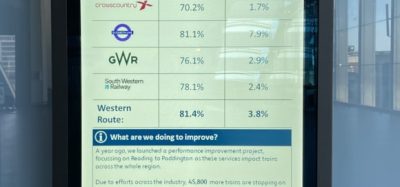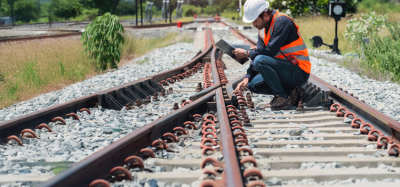Is there a future for Wi-Fi on board trains?
Posted: 23 August 2017 | | 2 comments
For Global Railway Review, Jeremy Haskey, Global Engineering Director & Chief Solutions Architect for Nomad Digital, discusses the future of Wi-Fi on board trains.


Everyday life is impacted by our ever-increasing expectations of the digital communications world. The more technology we have at our disposal, the more we expect from it – and if the technology doesn’t deliver to our high standards, our satisfaction levels drop. Currently, the expectations of rail passengers (who are using their electronic devices on trains to hook up to the train operator’s on-board Wi-Fi network) are clearly coloured by the wider existing perceptions of home broadband, office networks, and mobile wireless.
Connectivity is now perceived as a need – almost on a par with Maslow’s hierarchy of needs.
Yet almost oblivious to the 200km/h speed whilst hurtling along a track, a rail passenger just wants the same Wi-Fi experience as they would expect in a static café on the high street. This expectation is natural, and therefore some educational and behavioural work needs to be done to set some realistic context and manage expectations. The challenge is that the bar is set so incredibly high by what we can all experience at home or in the office with instant, fast streaming on our smart phone.
And whilst internet access on-board trains was never meant to replicate a home broadband or office connection, we cannot escape the current comparisons in a user’s mind.
So, a useful starting point might be to look at what the UK’s Department for Transport (DfT) expect each UK train operating company (TOC) to offer their passengers in terms of on-board connectivity, through five Key Performance Indicators (KPIs).
They state that each passenger should receive 1MB per second throughput when connected to an on-train Wi-Fi system. And on busy routes, throughput (internet connection) should be available for 95% of the journey, and pro rata 1MB per user per minute should be available with a minimum of 30MB download.
And they have set out the services they expect passengers to consume to include:
- Business applications including email
- Internet browsing
- Video, film, news and music
- Social networks.
This sets a framework of expectation… to some degree. However, video, film and music absorbs more bandwidth than simple business email or internet browsing. As an agile business, Nomad has had to adapt to this demand for increasing bandwidth and high-definition media content.
As an innovator in the field of on-board Wi-Fi, Nomad originally responded to one of the key drivers for internet on trains back in 2002, which was to enable business passengers to use their travel time for productive work. Times have changed, and passengers are far more demanding now of the digital environment and related services, and therefore our products and solutions have responded and adapted to passenger demand.
Our original response to the demands of a train’s business traveller was to design an on-board communications platform based on connectivity provided by the aggregation of cellular networks – and we were the pioneers!
Following exponential growth in today’s world of mass communication consumption, particularly over the last two-to-three years with video and games, we are ultimately constrained by the cellular coverage that the train receives, and the ultimate throughput that the mobile network service providers offer in both rural and urban environments. We are acutely aware that coverage can be patchy and slow as the network is contended.
So, what do we see happening in the future and how are we gearing up for this?
We expect in the future to see the range of passenger services moving to the edge of the network (the mobile base station) to give a better experience. Ultimately, if the edge of the network moves from the base station to the train itself, then the services will be consumed directly from systems on-board the train. What does this mean for high-definition media content? It means we are moving into a world of media content delivered directly on-board.
So, what would these services look like? Services such as films, catch-up TV, news, magazine articles (and in the future, BBC iPlayer, Netflix and Amazon Prime) would be readily available alongside those who just want a more business-focused email or browsing function. This is something we at Nomad are already offering to several TOCs.
And with our eye on the roadmap to 5G we can see further developments to enhance the passenger experience, though currently 5G is unlikely to have mass coverage and is at least three years away from large commercial release.
So, for commuter customers who are less likely to be the main users of media services on the train, what value do they get from on-board connectivity?
In this instance, we feel the integration of onward travel data to inform passengers in real-time on the status and next step of their journey will be of increasing importance. Relevant information can be pushed to passengers through an app or an on-train portal, as multimodal information (from a variety of modes of transport e.g. buses and trams) is becoming something more for the present time than the future.
This opens opportunities such as car sharing, Uber integration, underground/overground connections, cycle hire, onward journey and disruption updates. For the commuter, this is a high-value, data service that really enhances their journey experience.
A variable passenger profile
Another consideration is that the profile of the passengers within the digital journey clearly varies throughout the day, from day-to-day throughout the week and we have to be mindful of that. So, providing a mix of services on-board that are either hosted on the framework – or which can be accessed by the on-board Wi-Fi connection – provides flexibility and future-proofing.
Our systems need to be able to flex and respond to the increasing demands, and the limitations of the cellular coverage. We have to be versatile and adaptable. And, of course, we need to be geared up for new technology and infrastructure so we can quickly adopt and influence that, such as the advent of 5G.
But our view has always been to support train operators who want to provide high-value services to their passengers that are bespoke and tailored accordingly – and our ability to leverage Wi-Fi connectivity on trains will continue to play an instrumental role in that.
Biography
Jeremy Haskey is Nomad Digital’s Global Engineering Director and has been with the company for three years with responsibility for the architecture of Nomad’s range of innovative technological solutions for the market place.
He has over 25 years of experience in designing telecommunications networks for major service providers and national critical infrastructure in the transportation market, including safety critical systems for road-based traffic control and railway signalling. Notably, he was the named architect with the British government for the £500 million National Roads Telecommunications Services project.
He has held several senior positions at Vice President level with prominent telecommunications companies, including Alcatel Lucent and Newbridge Networks and has deployed projects across the world. He is also an elected member within the Confederation of British Industry and has a degree in engineering and a post-graduate qualification in business administration.
Related topics
Digitalisation, Passenger Experience/Satisfaction, Passenger Information Systems (PIS), Wi-Fi







On board WiFi is a great way to attract customers. I myself would choose the service with WiFi rather than the one with no WiFi since it keeps you entertained and you won’t be bored on the way.
Good view of the future for on-train WiFi and on-board media services – what do you think of the future for bespoke track-side wireless networks?